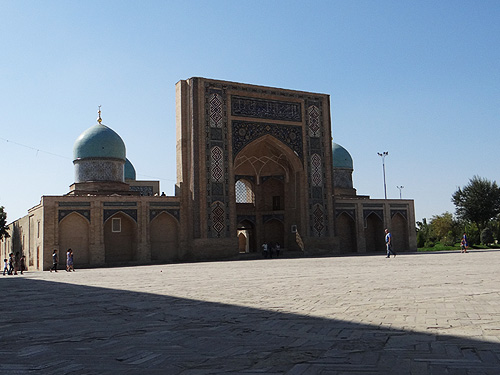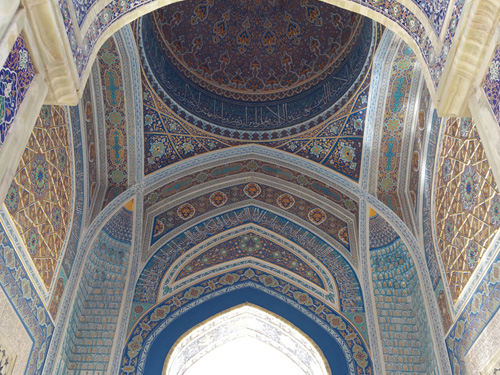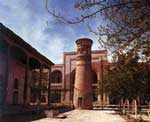
|
| Travel News | |||
| |||
| |||
|
| read all news |
|
|
|
|
|
| Last updated: 30 Nov 2022 |
Religious and Sacred Places in Uzbekistan
Uzbekistan as a part of Central Asia, contains a great number of religious monuments, buildings and sacred places. Their history encompasses more than 3000 years, starting with ancient monuments of the unique Zoroastrian religion. Zoroastrian people worshiped land, air and water, but fire was its main sacred element. Museums of Samarkand and Bukhara keep many relics and objects of that age, such as ossuaries.
Another ancient religion that influenced the cultural diversity in Central Asia and neighboring Afghanistan was Buddhism, and a number of interesting monuments are still remaining in the some areas of Uzbekistan, such as Termez and Ferghana valley. Two hundred years after the birth of Christ, Christians emerged in Maveranahr to never leave it. Their churches and temples co-existed with Zoroastrian temples and, later, with Islamic mosques for centuries. A number of famous monuments which are now known as mosques, were previously churches, for example, the Poi Kalyan Mosque in Bukhara. Islam emerged in Central Asia in the 8th century AD and till now it is the dominating religion in the region. Muslim cultural heritage comprises hundreds of monuments in all five republics of Central Asia and include buildings of secular, civic and religious nature. Those are palaces, houses, madrassah, khonaka, mosques and minarets, mausoleums and mazars, chillyakhonas. Below we present a short description of main attractions for tourists and travelers who may be interested in exploring the amazing cultural and religious diversity of present Uzbekistan. TashkentMausoleum of Abu-Bakr-Muhammad Kafal Al Shashi Kafal Al-Shashi originated from the Shash region (present Tashkent) and was a missionary who propagated shafiitism. Also, he was a very educated person and mystic poet. He died in 10th century AD and his mausoleum, rebuilt in 16th century, was a popular pilgrimage destination for thousands of Muslims. Madrassah Barak-khan and Cathedral Mosque Built in 16 century by Ulugbek's grandson Suyunij-khan. Presently it accommodates the Clerical Board of Muslims of Central Asia. Next to it is the Board's Library, containing a precious Koran written by the famous fourth Caliph Osman, known as the compiler of Holy Korans for the entire Islamic world. The legend goes that he was murdered while working with the book, and it still keeps blood stains on its pages made of gazelle skin. Zangiata Complex Two single-chamber mausoleums were built by Timur to commemorate the famous Black Khodja (Zangiata) and his wife Ambar Bibi. They were the followers of the outstanding leader of all Turkic tribes in Central Asia, Sufi Akhmad Yassavy. Like Ismail Bukhori and Bahauddin Nakshbandi they belonged to one of the Sufi trends in Islam. BukharaBahauddin Nakshbandi Complex Sheikh Bahauddin Nakshbandi (died in 1389) was a spiritual tutor of Timur. He is highly respected in Bukhara as a Saint and protector of handcraftsmen. A pilgrimage to his grave was considered as an adequate substitution of Hajj to Mecca. Before Arabs brought Islam to Central Asia, the place of the present Bahauddin's grave was a pagan temple of a Dying God, whose blood was symbolized by petals of red roses. Later, a number of buildings were constructed here, including a small minaret and sakokhona. SamarkandIsmail Bukhori Complex The mazar of Muhammad Ibn Ismail Bukhori is located 12km north of Samarkand. Recently an impressive renovation was carried out using funds from all over the Islamic world. Precious onyx slabs now decorate the grave of one of the most prominent Saints and personalities of Islam, who lived in 9th century. He spent 12 years in Mecca learning and collecting various khadises - legends and rules of Islam. Many of them later were used as the basis for Sharia, Law of Muslims. |
Related pages | |||||||||||||||||||
Tourism in Uzbekistan
| Uzbek Cuisine
| ||||||||||||||||||
History of Uzbekistan
| Folk Art and Handcrafts in Uzbekistan
| ||||||||||||||||||
Modern Art
| |||||||||||||||||||
CompanyAbout Aba Travel CompanyContacts Testimonials Mobile version of the website Auto screen selection |
Travel ServicesTourist Visas for UzbekistanUzbekistan Airlines Hotels in Uzbekistan Tourist Maps Tour guides Tourist Transport |
Travel AdviceTravel Guide UzbekistanUzbekistan FactsTourism in Uzbekistan |
DestinationsUzbekistanKyrgyzstan Kazakhstan Tajikistan Turkmenistan |
ToursTours in UzbekistanTours in Kyrgyzstan Tours in Tashkent Tours in Samarkand Tours in Bukhara Tours in Khiva |
|
Aba Travel Company, Tashkent, Uzbekistan
Legal Name: OOO Aba Trip Plus
Sarykul 9 Str.
tel:
100167, Tashkent, Uzbekistan
|
License No. T-0045-14 of Uzbek Tourism Authority 'UzbekTourism'
| ||||||||||||
|
Copyright © 2001. All rights reserved. All material/content from this website can be reproduced in electronic or printed form if a reference (a hyperlink for the Web or citation for printed media) is made to abasayyoh.com | |||||||||||||




















